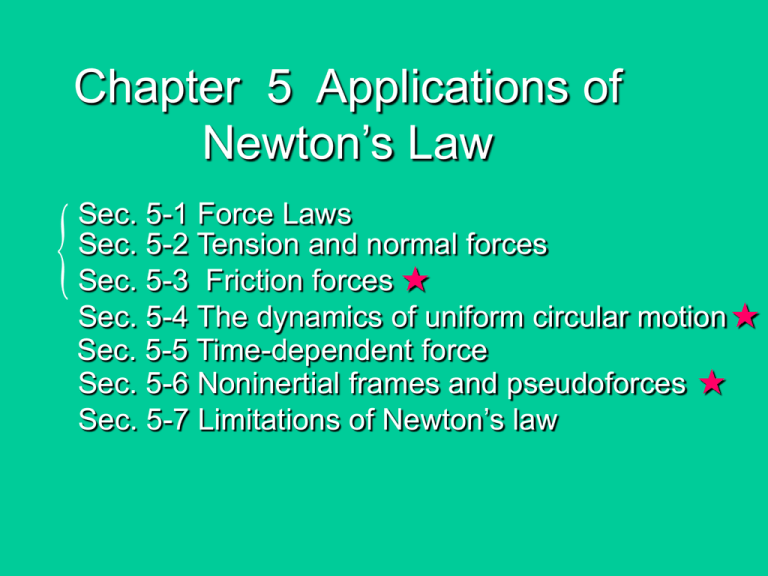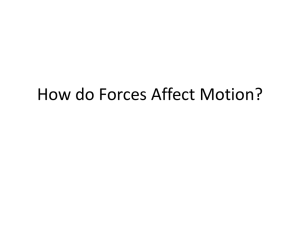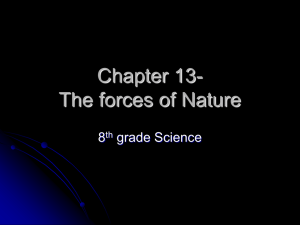Chapter 5 Applications of Newton`s Law
advertisement

Chapter 5 Applications of Newton’s Law Sec. 5-1 Force Laws Sec. 5-2 Tension and normal forces Sec. 5-3 Friction forces ★ Sec. 5-4 The dynamics of uniform circular motion ★ Sec. 5-5 Time-dependent force Sec. 5-6 Noninertial frames and pseudoforces ★ Sec. 5-7 Limitations of Newton’s law Sec. 5-1 Force Laws Physicists have traditionally identified four basic forces: (1) the gravitational force (2) the electromagnetic force (3) the weak nuclear force, which causes certain radioactive decay processes and certain reactions among the fundamental particles. (4) the strong force, which operates among the fundamental particles and is responsible for binding the nucleus together. Two protons in typical nucleus, for example, the relative strength of these forces would be: strong (relative strength = 1); 2 10 electromagnetic( ); weak ( 109); gravitational ( 1038). In fact, everything we study about ordinary mechanical systems involves only two force: gravity and electromagnetism. Tension forces Normal forces Friction forces Sec. 5-2 Tension and normal forces (张力与压力) (1) Tension force (such as in a stretched rope or string), arises because each small element of the string pulls on the element next to it. m If the mass of the rope is negligible, the values of the force exerted on the two ends of the rope must be nearly equal to each other. (2) Normal force : Just like tension force, the normal force is also contact force. N N' Both tension and normal forces originate with the atoms of each body --- each atom exerts a force on its neighbor. They belong to electromagnetic forces. Sample problem: 5-7 In a system, a block (of mass m1 = 9.5 Kg) slides on a frictionless plane inclined at an angle 34 . The block is attached by a string to a second block (of mass m2=2.6 Kg). The system is released from rest. Find the acceleration of the blocks and the tension in the string. m2 Sec. 5-3 Friction forces ★ Friction is the force that opposes (反抗) the relative motion or the trend of relative motion of two solid surfaces in contact Friction static friction kinetic friction sliding friction √ rolling friction 1) The forces of static friction (静摩擦力) The frictional forces acting between surfaces at rest with respect to each other. Friction force can be measured by following expt. Fig 5-12 Friction force fk fsMax fs rest moving The maximum force of static friction will be the same as the smallest applied forces necessary to start motion. The maximum force of static friction f s Max between any pair of dry unlubricated surface follows these two empirical laws : (1) It is approximately independent of the area of contact surfaces. (2) It is proportional to the normal force f s Max s N (5-7) where N the magnitude of the normal force, s the coefficient of static friction, f s Max the maximum force of static friction. f s f s Max 2)The force of kinetic friction(动摩擦力, (滑动)): f k k N (5-8) where k is the coefficient of kinetic friction. Usually, for a given pair of surfaces s k. The actual value of s and k depend on the nature of both the surfaces in contact. Table 5-1 some representative values of s and k . Surface s k 1.0 0.8 Rubber on dry concrete Glass on glass 0.9 ~ 1.0 0.4 Steel on steel 0.6 0.6 Wood on wood 0.25 ~ 0.5 0.2 Waxed wood ski on dry snow 0.04 0.004 Sample problem: 5-10 Repeat Sample Problem 5-7, taking into account a frictional force between block 1 (m1) and the plane. Use the values s =0.24 and k =0.15. Find the acceleration of the blocks and the tension in the string. m1 = 9.5 Kg m2=2.6 Kg 34 m2 Sec. 5-4 The dynamics of uniform circular motion 1) The conical pendulum(锥摆) Fig 5-18 T L m R m v mg Fig 5-18 shows a conical pendulum, as the mass m is revolving in a horizontal circle with constant speed v, the string L sweeps over the surface of an imaginary cone. Can we find the period of the motion? T cos mg { 2 T sin mar mv / R (R L sin ) (5-12) (5-13) v Rg tan If we let t represent the time for one complete revolution of the body, then 2R R L cos t 2 2 v g tan g t is called the period of motion. Fig 5-20 2) The banked curve Let the block in Fig 5- v 20 represent an a) R automobile or railway c car moving at constant speed v on a level v roadbed around a curve having a radius b) of curvature R. Where does the centripetal force come from? a): sidewise frictional force exerted by the road on the tires. b): N sin mv / R 2 N cos mg 2 tan v / Rg Example 1 Example 2 See 动画库/力学夹 /2-02牛顿定律例题 .exe 例3 Problem: A child whirls a stone in a horizontal circle 1.9 m above the ground by means of a string 1.4 m long. The string breaks, and the stone flies off horizontally, striking the ground 11m away. What was the centripetal acceleration of the stone while in circular motion? Sec. 5-5 Time-dependent force If the forces are dependent on time, we can still use Newton’s laws to analyze the motion. For simplicity, we assume here that the forces and the motion are in one dimension, which we take to be the x direction. Then dv Fx(t) ma(t) m dt Fx (t ) dvx dt m (5-18) vx v0 x dvx t 0 v x (t ) v0 x 1 t Fx (t ) dt or v x v0 x 0 F(t)dt m m 1 t F (t )dt m 0 (5-19) wherev0 x is initial velocity, v is the velocity at x time t. dx v In the same way with x dt , we have t x(t ) x0 v x (t )dt 0 (5-20) If Fx is a constant, Eqs. 19 and 20 will reduce to the formula we obtained for const. acceleration motion. Discussion Basic concepts in kinematic motion: a, v , r , t How about the motion if the acceleration is a function of position, such as a spring oscillator? F kx v(t)? a(t)? 2 dv d x F kx m m 2 mx dt dt k x Acos(ωt φ), ω m A and φ are determined by initial conditions. Sample problem 5-11 A car of m=1260kg is moving at 105 km/h. the driver begins to apply the brakes so that the magnitude of the braking force increases linearly with time at the rate of 3360N/s (a) How much time passes before the car comes to rest? (b) how far does the car travel in the process? Solution: (a) we choose the direction of the car’s velocity as the positive x direction, then we can represent the braking force as F ct 3360t N x 1 t ct 2 and vx (t) v0 x (ct)dt v0 x m 0 2m Let this expression for vx equal to zero and solve for t, 2v0 x m 2(29.2m / s)1260kg t1 4.68s c 5360N / s The car comes to rest at t1 4.68s (b) According to Eq(5-20) t ct 2 ct 3 x x0 (v0 x )dt x0 v0t 2m 6m 0 Evaluating the expression at t t1 , x0 0 we obtain (3360N / s)(4.68s)3 x(t1 ) (29.2m / s)(4.68s) 91.1m 6(1260kg) Fig 5-22 x v t1 t (s) ct 3 x x 0 v0 t 6m 2 a t1 t (s) t1 t (s) ct v x ( t) v0 x 2m ax (t ) ct / m Sec. 5-6 Noninertial frames and pseudoforces(赝力) 1) How is the motion equation if a noninertial frame is chosen? Noninertial frame--- a frame that is accelerated as viewed from an inertial frame. See an example Consider an observer s’ in a van that is moving at constant velocity. The van contains a long airtrack with a frictionless 0.25kg glider at one end (Fig 522a). The driver of the van applies the brakes, and the van begins to decelerate with acceleration of a . Fig 5-22 (a) o S v a 0 o S’ a’ a0 a ' a (b) a' Observer S’ sees the glider accelerate with and can find no object in the environment of the glider that exerted a force on it. At same time S measures the van accelerate with a . It is found that the relationship between the two . accelerates is a ' a To preserve the applicability of Newton’s Second law, S’ must assume that a force (a pseudo-force) acts on the glider. According to S’, this force F ' must equal ma ' ma . To apply classical mechanics in noninertial frames ( a ), we must introduce additional forces known as ‘pseudoforces’ (sometimes called ‘inertial forces’(惯性力)). F ' ma 2) Why is the force called ‘pseudoforce’? Pseudoforces = non-Newtonian forces Pseudoforces violate Newton’s third law. The observer of s’ cannot find a reaction force exerted by the glider on some other body. Pseudoforces depends on the frames chosen. 3) Pseudoforces are very real to those that experience them. To S, who is in inertial frame (ground), this is quite natural; your body is simply trying to obey Newton’s first law and move in a straight line. From your point of view in the noninertial reference frame of the car, you must ascribe your sliding motion to a pseudo-force pulling you to the left. This type of pseudo-force is called a centrifugal force(离心力), meaning a force directed away from the center. 4) Is pseudoforce (inertial force) really pseudo? A virtual experiment • General Relativity: found in 1915 • Principle of equivalence: gravity ~ inertial force g Application of inertial forces: See 动画库/力学夹/2-02牛顿定 律例题.exe 例2 Sec. 5-7 Limitations of Newton’s law Special relativity teaches us that we can not extrapolate the use of Newton’s laws to particles moving at speeds comparable to the speed of light. General relativity shows that we can not use Newton’s laws in the vicinity of extremely massive objects. Quantum mechanics teaches us that we can not extrapolate Newton’s laws to objects as small as atoms.






